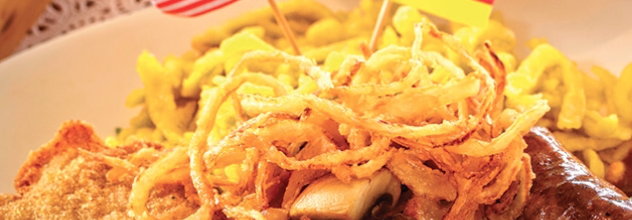Taste the world: Black Forest Adler

This article originally appeared in Buffalo Spree Magazine’s September 2017 issue.
The USA platter Includes a jager schnitzel (a pork cutlet pounded thin, breaded, fried, and smothered with a dark pork gravy and mushrooms), a generous pile of spatzle (homemade noodles boiled and pan seared), a rouladen (paper-thin slices of beef stuffed with dill pickle, onion, and bacon) and a maltaschen (a filling of ground beef, pork, and smoked bacon, spinach, and spices stuffed between thin sheets of pasta, topped with crispy onions). A second plate holds small mounds of prepared salads—cucumber dill, grated carrot, German potato salad, corn and bean, and macaroni—all topped with field greens and shredded Romaine tossed with a creamy house-made dressing and croutons.
Why is it called the USA Platter?
Gerhard Braun: “When I had my restaurant, Maltaschen, in Germany, every once in a while, a server would come back to the kitchen with an order for small portions of a few dishes. I’d say, ‘Oh, we have an American?’ It’s a very American tendency, so we honored that.”
Laura Braun: Many of our customers grew up around German food, but we have others who are new to it, so this gives them a chance to try a few different things.
How would you describe the food you serve?
LB: It’s home cooking; it’s very labor intensive. That’s why we’re only open 4–8 p.m. Wednesday through Saturday and not for lunch.
GB: Many restaurants are one-third prep, two-thirds serving. We’re the other way around.
LB: Think of when your grandma cooked for five hours to make one meal that’s eaten by a handful of people in twenty minutes, then times that by a few hundred people in a restaurant. He makes everything from scratch and does it all by hand.
GB: I’m a recipe and ingredient purist. I’m not changing either to fit another way. I hired a second chef from Berlin who knows what is what.
Are your dishes influenced by a particular region of Germany?
LB: Gerhard grew up in the Swabian region in southern part of the country. Other restaurants here are more Bavarian. The maltuschen is a uniquely Swabian dish.
GB: The story goes that there was a monastery of monks in Swabia who wanted to eat meat on a Friday during Lent, so they hid it between sheets of pasta so God couldn’t see it. The Swabian nickname for the dish is Herrgottsbescheißerle, “little cheaters of God.”
LB: A lot of people assume all German food is the same, but it’s like Italians and sauce. You might have German potato salad in five restaurants, and it’ll be a little different depending on where the cook came from.
Photo by KC Kratt
